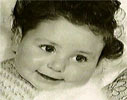
Discovering your toes
"This second element which will disturb the studium I shall therefore call punctum; for punctum is also: sting, speck, cut, little hole – and also a cast of the dice. A photograph’s punctum is that accident which pricks me (but also bruises me, is poignant to me”(Roland Barthes of course).
Not every museum object makes its screen debut in exactly the same way. Large scale installations delivered in a webpage suffer sorely - not only from their inevitable reduction - but also from our inability to sense the work with our own bodies. Fine oil works demand that you and I stand in close proximity to them in order to appreciate the delicate brushstrokes, and to absorb the faint aroma of resin so lovingly layered into the canvas. Online we miss the faint mustiness of the archaeological object that perches on its floodlit pedestal; looking just as if it had and burnished especially for us – that very moment – after being pulled out of a distant excavation. All those lost-aura moments that I referred to in my previous blog.
So why even bother looking for works and objects online – I hear you wondering; clearly – it's obvioulsy not even worth the effort!
How about we consume photography then? If the artist decides to produce a digital image, does it matter that we enjoy the image from the privilege of our own home computer? And even if it is a digital scan of one of the many prints the photographer has produced – does it really matter that the image comes to us over the ether rather than through a C-print? If you take the leap of faith that dares to suggest that the medium might not be quite so crucial to the work as we once might have thought, this might suggest that it might actually be the gesture of the work that is bruising us – even poignantly at times.
If I have persuaded you – even partially that there could be something remarkable in enjoying art telematically – then you will have to agree with me that there could be the possibility of a post-partum punctum – that 'aha' moment that takes us out of ourselves - even momentary even though the work was born elsewhere in its nascent physicality. The next part would be to persuade you that it is critical to engage with the art object within the portal of a museum rather than discovering an orphan image with incorrect or limited labeling that beguiles its true provenance. I personally believe that there aren't too many delivery systems that can compete with museum delivery. The museum extends into the Mediasphere those very same measures of truth and integrity that have their provenance in the physical museum. And If I have persuaded you so far of the veracity of the Musesphere, then I dare you come back to my blog in the near future to continue this journey with me.... you never know .... you might even discover your own toes.

